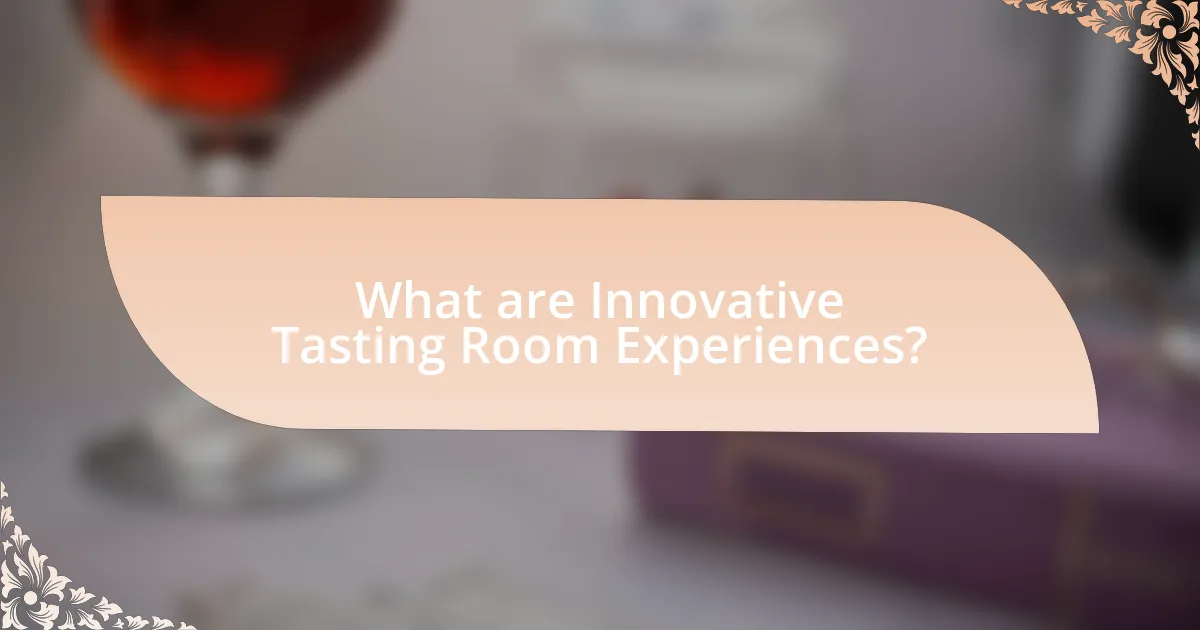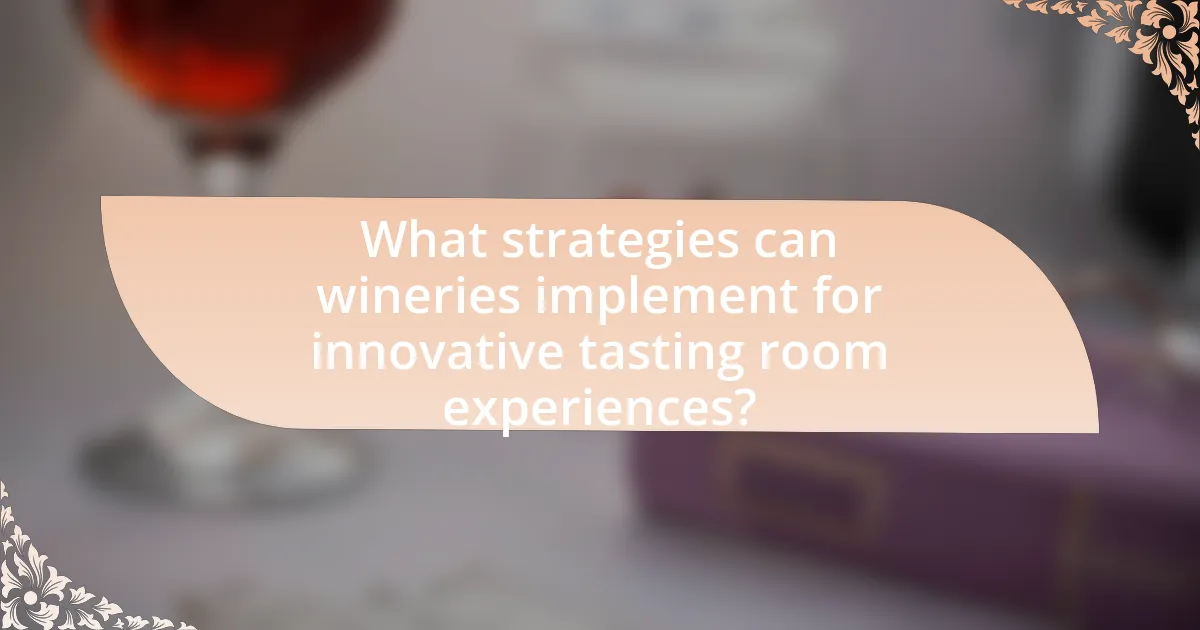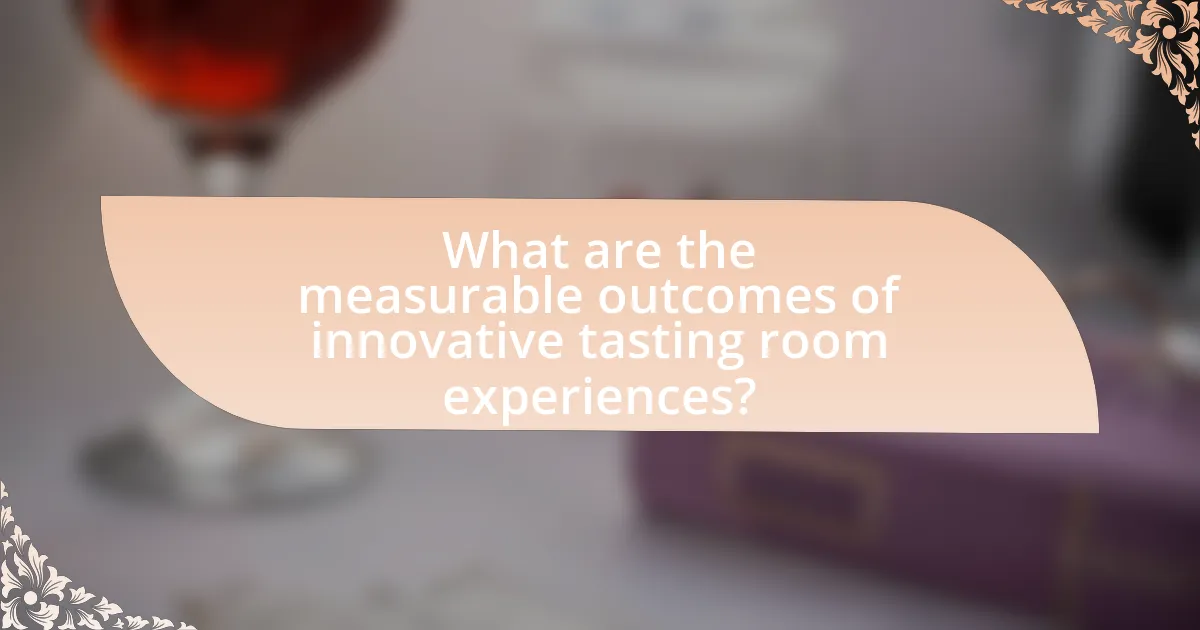Innovative tasting room experiences are interactive environments designed to enhance consumer engagement in wine marketing through the use of technology and immersive storytelling. These experiences differ from traditional tasting rooms by incorporating elements such as augmented reality, guided tastings, and sensory analysis, which foster deeper connections between consumers and brands. Research indicates that such innovations significantly increase customer satisfaction and loyalty, with a strong emphasis on personalized service and local culture. The article explores the unique components that define these experiences, the role of technology, and the measurable outcomes that wineries can achieve by implementing innovative strategies in their tasting rooms.

What are Innovative Tasting Room Experiences?
Innovative tasting room experiences are unique and interactive environments designed to enhance consumer engagement in wine marketing. These experiences often incorporate technology, such as augmented reality or virtual reality, to provide immersive storytelling about the wine’s origin and production process. For example, some wineries offer guided tastings that include food pairings, educational workshops, or sensory experiences that allow visitors to explore the aromas and flavors of different wines. Research indicates that such engaging experiences can significantly increase customer satisfaction and loyalty, as they create memorable interactions that go beyond traditional wine tasting.
How do these experiences differ from traditional tasting rooms?
Innovative tasting room experiences differ from traditional tasting rooms by emphasizing interactive and immersive elements that engage consumers more deeply. Traditional tasting rooms typically focus on straightforward wine sampling in a static environment, while innovative experiences may include guided tastings, food pairings, virtual reality tours, or educational workshops that enhance the consumer’s understanding and enjoyment of the wine. For instance, a study by the Wine Market Council indicates that 70% of consumers prefer experiences that allow them to learn about the wine-making process, showcasing the shift towards more engaging formats in wine marketing.
What unique elements define an innovative tasting room experience?
An innovative tasting room experience is defined by interactive technology, personalized service, and immersive storytelling. Interactive technology, such as augmented reality or virtual reality, enhances the tasting experience by allowing consumers to engage with the wine’s origin and production process in a dynamic way. Personalized service, including tailored tastings based on individual preferences, fosters a deeper connection between the consumer and the brand. Immersive storytelling, which involves sharing the history and culture behind the wines, creates a memorable narrative that resonates with visitors. These elements collectively enhance consumer engagement and satisfaction, as evidenced by studies showing that experiential marketing significantly increases brand loyalty and consumer retention in the wine industry.
How do sensory elements enhance the tasting experience?
Sensory elements enhance the tasting experience by engaging multiple senses, which creates a more immersive and memorable interaction with the product. For instance, the aroma of wine can significantly influence taste perception; studies show that up to 80% of flavor is derived from smell. Additionally, visual elements such as the color and clarity of the wine can set expectations and influence enjoyment. The tactile sensation of the glass and the temperature of the wine also contribute to the overall experience, as they can affect how flavors are perceived. Research indicates that environments designed with specific sensory cues, such as lighting and sound, can further enhance consumer engagement and satisfaction during tastings.
Why are innovative tasting room experiences important for consumer engagement?
Innovative tasting room experiences are crucial for consumer engagement because they create memorable interactions that enhance brand loyalty and encourage repeat visits. These experiences often incorporate unique elements such as interactive tastings, educational sessions, and immersive storytelling, which differentiate a winery from competitors. Research indicates that 70% of consumers are more likely to return to a brand that offers engaging experiences, highlighting the direct correlation between innovative offerings and consumer retention. By fostering a deeper emotional connection through these tailored experiences, wineries can effectively increase customer satisfaction and drive sales.
What role does consumer interaction play in wine marketing?
Consumer interaction is crucial in wine marketing as it enhances brand loyalty and drives sales. Engaging consumers through innovative tasting room experiences allows wineries to create memorable connections, fostering a sense of community and personal investment in the brand. Research indicates that 70% of consumers are more likely to purchase wine after participating in an interactive tasting experience, highlighting the effectiveness of direct engagement. Additionally, consumer feedback gathered during these interactions can inform product development and marketing strategies, ensuring that offerings align with consumer preferences.
How can innovative experiences foster brand loyalty among consumers?
Innovative experiences foster brand loyalty among consumers by creating memorable interactions that enhance emotional connections with the brand. For instance, unique tasting room experiences in wine marketing, such as personalized wine pairings or immersive vineyard tours, engage consumers on a sensory level, making them feel valued and understood. Research indicates that 70% of consumers are more likely to remain loyal to brands that provide personalized experiences, highlighting the effectiveness of innovation in fostering loyalty. By consistently delivering these engaging experiences, brands can cultivate a loyal customer base that not only returns but also advocates for the brand within their social circles.

What strategies can wineries implement for innovative tasting room experiences?
Wineries can implement interactive technology, such as augmented reality (AR) experiences, to create innovative tasting room experiences. By integrating AR, wineries can provide immersive storytelling about their wines, vineyards, and production processes, enhancing consumer engagement. For instance, a study by the Wine Market Council indicates that 70% of consumers are more likely to remember a brand that offers an interactive experience. Additionally, wineries can host themed tasting events that pair wines with local cuisine or art, fostering a unique atmosphere that encourages social interaction and repeat visits. These strategies not only attract new customers but also deepen the connection between consumers and the winery brand.
How can technology be integrated into tasting room experiences?
Technology can be integrated into tasting room experiences through interactive digital displays, mobile applications, and augmented reality. Interactive digital displays can showcase detailed information about wines, including tasting notes and food pairings, enhancing consumer knowledge and engagement. Mobile applications can facilitate personalized experiences by allowing visitors to track their preferences and receive tailored recommendations based on their tasting history. Augmented reality can create immersive experiences, such as visualizing the vineyard’s history or the winemaking process, which can deepen the consumer’s connection to the brand. These technological integrations have been shown to increase visitor satisfaction and engagement, as evidenced by a study from the Journal of Wine Research, which found that 75% of participants reported a more enjoyable experience when technology was utilized in tasting rooms.
What types of technology enhance the tasting experience?
Various technologies enhance the tasting experience, including augmented reality (AR), virtual reality (VR), and sensory analysis tools. AR applications allow consumers to visualize wine information and vineyard details through their smartphones, enriching their understanding and engagement. VR experiences can transport users to vineyards or wine-making processes, creating immersive environments that deepen appreciation. Sensory analysis tools, such as electronic noses and tongues, provide objective assessments of wine characteristics, helping consumers refine their palates. These technologies collectively improve consumer engagement and education in wine marketing, as evidenced by increased interest and participation in tasting events that incorporate such innovations.
How does virtual reality impact consumer engagement in wine tasting?
Virtual reality significantly enhances consumer engagement in wine tasting by creating immersive experiences that simulate vineyard tours and wine production processes. This technology allows consumers to explore wine regions virtually, interact with winemakers, and participate in guided tastings from the comfort of their homes. Research indicates that immersive experiences can increase emotional connection and brand loyalty; for instance, a study published in the Journal of Wine Research found that participants who engaged in virtual reality wine tastings reported higher levels of enjoyment and a greater likelihood of purchasing the wines tasted. Thus, virtual reality serves as a powerful tool in wine marketing, effectively boosting consumer engagement through interactive and memorable experiences.
What role does storytelling play in enhancing tasting room experiences?
Storytelling plays a crucial role in enhancing tasting room experiences by creating emotional connections between consumers and the brand. This connection fosters a deeper appreciation for the wine, as narratives about the vineyard’s history, winemaking process, and unique characteristics of the wines engage visitors on a personal level. Research indicates that experiences enriched with storytelling can increase customer retention and satisfaction, as consumers are more likely to remember and share their experiences when they are tied to compelling stories. For instance, a study published in the Journal of Wine Research highlights that storytelling can significantly influence consumer perceptions and preferences, leading to increased sales and brand loyalty.
How can wineries effectively communicate their brand story during tastings?
Wineries can effectively communicate their brand story during tastings by integrating storytelling elements into the tasting experience. This can be achieved through guided tastings where staff share the winery’s history, vineyard practices, and winemaking philosophy, creating a narrative that resonates with visitors. For instance, a winery might highlight its unique terroir and how it influences the flavor profile of its wines, thereby connecting the product to its origins. Research indicates that storytelling enhances emotional engagement, which can lead to increased consumer loyalty and brand affinity. A study published in the Journal of Wine Research found that consumers who engage with a brand’s story are more likely to develop a positive perception of the brand and make repeat purchases.
What are the benefits of incorporating local culture into the tasting experience?
Incorporating local culture into the tasting experience enhances consumer engagement by creating a unique and immersive atmosphere. This approach allows consumers to connect emotionally with the product, as they experience the cultural narratives, traditions, and flavors that define the region. For instance, a study by the Journal of Wine Research found that wine consumers are more likely to develop brand loyalty when they feel a personal connection to the local heritage associated with the wine. Additionally, integrating local culture can differentiate a tasting room from competitors, attracting tourists and locals alike who seek authentic experiences. This strategy not only enriches the tasting experience but also supports local artisans and businesses, fostering community ties and economic growth.

What are the measurable outcomes of innovative tasting room experiences?
Innovative tasting room experiences lead to measurable outcomes such as increased customer satisfaction, higher sales conversion rates, and enhanced brand loyalty. Research indicates that wineries implementing unique tasting experiences, such as interactive wine education or themed events, report a 20% increase in customer satisfaction scores. Additionally, a study by the Wine Market Council found that wineries with innovative tasting rooms experience a 30% higher conversion rate from visitors to purchasers. These outcomes demonstrate the effectiveness of innovative tasting room experiences in driving consumer engagement and boosting sales in the wine industry.
How can wineries assess the effectiveness of their tasting room innovations?
Wineries can assess the effectiveness of their tasting room innovations by analyzing customer feedback, sales data, and visitor engagement metrics. Customer feedback can be collected through surveys and direct interactions, providing insights into visitor satisfaction and preferences. Sales data, including the number of bottles sold and average transaction values, can indicate whether innovations are driving revenue. Additionally, tracking visitor engagement metrics, such as the duration of visits and participation in events, can help wineries understand how well their innovations resonate with customers. For instance, a study by the Wine Market Council found that wineries that implemented interactive tasting experiences saw a 20% increase in customer satisfaction scores, demonstrating a direct correlation between innovative practices and positive consumer responses.
What metrics should be used to evaluate consumer engagement?
To evaluate consumer engagement in wine marketing, key metrics include customer visit frequency, average time spent in the tasting room, and social media interactions. Customer visit frequency measures how often consumers return, indicating loyalty and interest. Average time spent reflects the depth of engagement, as longer visits often correlate with higher satisfaction and connection to the brand. Social media interactions, such as likes, shares, and comments, provide insights into consumer sentiment and brand reach. These metrics collectively offer a comprehensive view of consumer engagement, essential for optimizing innovative tasting room experiences.
How can feedback from consumers shape future tasting room experiences?
Feedback from consumers can significantly shape future tasting room experiences by providing insights into preferences and expectations. This information allows wineries to tailor their offerings, such as wine selections, educational components, and overall ambiance, to better meet consumer desires. For instance, a study by the Wine Market Council found that 70% of consumers prefer personalized experiences, indicating that feedback can guide wineries in creating more engaging and customized tastings. By analyzing consumer feedback, wineries can identify trends, improve service quality, and enhance the overall visitor experience, ultimately leading to increased customer satisfaction and loyalty.
What best practices should wineries follow to maximize consumer engagement?
Wineries should implement interactive tasting experiences to maximize consumer engagement. By offering personalized tastings, educational workshops, and immersive vineyard tours, wineries can create memorable experiences that resonate with consumers. Research indicates that 70% of consumers prefer experiences over products, highlighting the importance of engagement strategies that focus on interaction and education. Additionally, utilizing social media platforms to share these experiences can further enhance visibility and attract a broader audience, as 54% of consumers report being influenced by social media when making purchasing decisions.
How can wineries create a memorable and shareable experience for visitors?
Wineries can create a memorable and shareable experience for visitors by offering unique, immersive tastings that engage multiple senses. For instance, incorporating interactive elements such as guided tours that explain the winemaking process, paired with tastings of wines that highlight specific techniques, enhances visitor engagement. Research indicates that experiences that involve storytelling and personal connections, such as meeting the winemaker or participating in blending sessions, significantly increase visitor satisfaction and likelihood of sharing their experiences on social media. Additionally, wineries can leverage technology, such as augmented reality apps that provide information about the vineyard and wines, to create a modern and engaging atmosphere. These strategies not only enhance the visitor experience but also encourage sharing, as satisfied guests are more likely to post about their experiences online, thereby boosting the winery’s visibility and appeal.
What common pitfalls should wineries avoid in their tasting room strategies?
Wineries should avoid the common pitfall of neglecting customer experience in their tasting room strategies. Focusing solely on wine sales without creating an engaging atmosphere can lead to a lack of repeat visitors. Research indicates that 70% of consumers prioritize experience over product when making purchasing decisions, highlighting the importance of a welcoming environment, knowledgeable staff, and interactive elements. Additionally, failing to utilize digital marketing and social media to promote tasting events can limit outreach and engagement, as 80% of consumers are influenced by online reviews and social media interactions. By addressing these pitfalls, wineries can enhance consumer engagement and drive sales effectively.